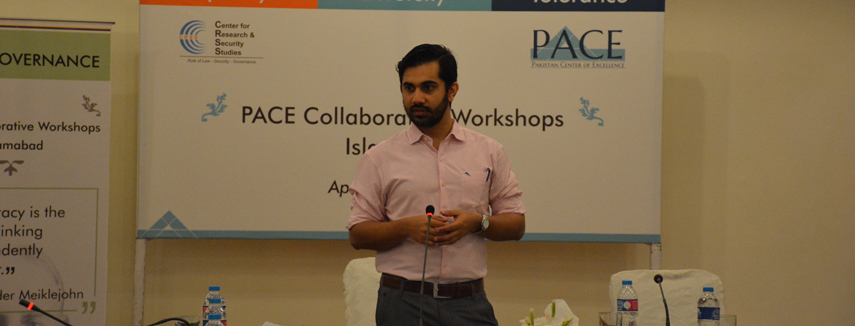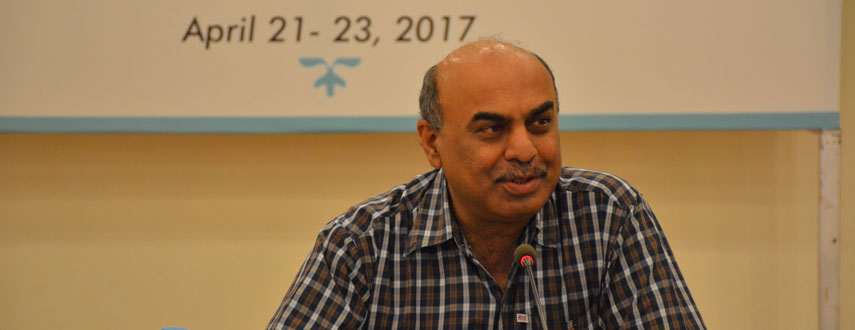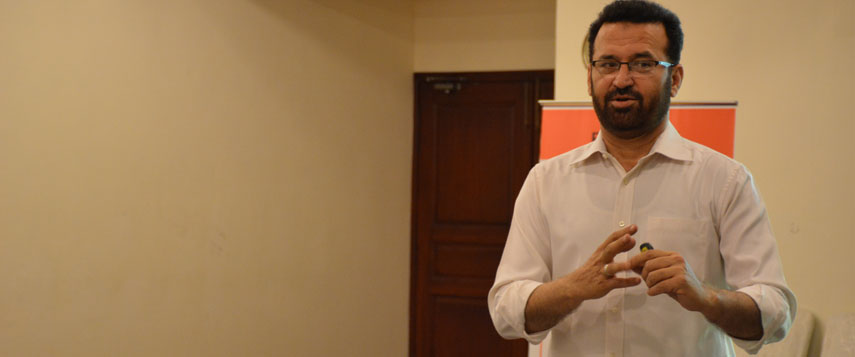OPENING CEREMONY
Mr. Zeeshan Salahuddin, Project Manager, welcoming the participants to the workshop said that PACE workshops gather a diverse group of university teachers from all across Pakistan every month to pull together a wide spectrum of ideas. “Teachers are the real gate keepers of the society because they are shaping the future generations and are greatly influencing the lives of their students in multifarious ways,” he said. Introducing the PACE project, he said that it is an initiative by CRSS to counter radicalization, inculcate critical thinking, question preconceived notions and narratives, and embed a national discourse in constitutionalism and rule of law.
WORKSHOP CORE AREAS
The young professionals were trained in following areas:
- Leadership and motivation
- Equal citizenry and respect for rule of law
- Fundamentals of democracy, governance and accountability
- Respect for diversity, opinions and rights
- Rights of minorities and other marginalized groups
- Constitutionalism, and adherence to Pakistan’s Constitution, particularly articles 8-28
- The importance of asking critical questions in the pursuit of knowledge
PLURALISM AND MULTICULTURALISM, MS. HUMAIRA MASIHUDDIN
Ms. Humaira Masihuddin kicked off first formal session of the day speaking on the theme of ‘Pluralism and Multiculturalism’. She said that human beings belong to one origin and one place, she said, and no purely homogeneous society exists in the modern world. Most societies consist of different ethnic groups. She defined minorities as a group of people who are singled out from the other groups and are treated differently because of their physical or cultural characteristics. Minority is a subordinate group as opposed to the dominant group.
The concept of multiculturalism revolves around a society with heterogeneous beliefs and set of ideas. Multiculturalism makes a society diverse. Respect for diversity shapes coexistence, peace, and harmony under a political and institutional framework. Differences are not challenges and do not impose any limitation on growth of an individual or society. Every individual has a right to be different and be respected by all. In Islam, the concept of diversity is clearly inclusive, she continued. In the Quran, she said, humans are addressed to treat one another without any discrimination and respect each other’s beliefs and should never use abusive language or show disrespect towards others. If we look at the character of the Holy Prophet (PBUH), it is evident how He always respected the non-Muslims in Mekkah and Medina. Even on the day Mekkah was conquered by Muslims, Prophet (PBUH) forgave all His enemies for the harms that they had inflicted on Him. Ms. Humaira also made note of the last sermon of the Holy Prophet that said “All mankind is from Adam and Eve, an Arab has no superiority over a non-Arab nor a non-Arab has any superiority over an Arab; also a white has no superiority over black nor a black has any superiority over white except by piety (taqwa) and good action.” In short, Islam is the religion of tolerance and coexistence, love and peace for others regardless of their religion or ethnicity.
FUNDAMENTALS OF DEMOCRCAY, GOEVRNANCE AND ACCOUNTABILITY, DR. QIBLA AYAZ
Dr. Qibla Ayaz kicked off the workshop’s second session on the first day and discussed the topic of ‘Fundamentals of Democracy, Governance and Accountability’. He stimulated the discussion relating it to the current socio-political situation of the Pakistan in wake of Panama Leaks, NAB, and accountability commissions. He also compared and contrasted the new form of electoral democracy that has taken birth in USA, entirely different from that of eight years back election when Obama was elected. Now USA is more focused on localization by restricting the domestic politics to white people.
He took the participants back into the history of democracy that has evolved through different stages. Citizens have experienced different forms of governments in the past such as aristocracy, dictatorship, and dictatorship of the religion. Islamic history has also gone through the same phases; such as dynastic rule by a few families. Across these historical phases, democracy has emerged as the best state system. Among other forms of democracy are parliamentary and presidential systems.
Fostering discussion around aspects of democracy i.e. outward and inward appearances, he said that the outward appearance is the structural election process whereas inward appearance deals with the accountability of the representatives of the people. The inward appearance is the spirit of the democracy. Accountability is a prerequisite for democratic systems. Talking about lack of sustainability of democracy in Pakistan, he said that democracy has not failed in Pakistan but it has always been portrayed as a failed system. Democracy stabilizes with able leadership and this is what we lack in Pakistan. Good governance can emerge only if democracy is mature and stable. Good governance is based on social justice, rule of law, and provision of fundamental human rights.
SURGE IN RELIGIOSITY IN SINDH: WHY? MR. NASEER MEMON
Mr. Naseer Memon was the first speaker on the second day and spoke on the causes of religiosity in Sindh. He shared his views saying that we, as a nation, witnessed the most brutal and inhuman act in Mardan university followed by another heinous act of murder in Sialkot by three sisters of a young man; an alleged blasphemer. An accused blasphemer has become an easy prey, you just point out to the person and nobody will question the motive behind the murder, but the way religion is being connected with violence and brutality is appalling. We can see a surge in such incidents for a quite a long time.
For the last few years, we have witnessed the rise in violence in Pakistan. We need to address the youth, who are set to go out in various sectors of society and shape up the future of this country.
Speaking about the surge of religiosity in Sindh, Mr. Memon said that situation on ground is not really good. Sindh has, so far, been the most tolerant province in context of violence and extremism and it continues to be if compared with other provinces as of today. It is in a far better position in many ways, doesn’t mean to get a sense of complacency. But we have to admit that there are things that are moving in the wrong direction. Elements that have affected Balochistan and KP, we, now can see them emerging in Sindh also.
He said that we have witnessed the attack on Sehwan Sharif and a few other incidents that took place in the northern side of Sindh. Looking back to the era of partition, the center of violence was Punjab, on both sides. Communal violence was almost unseen in Sindh at that time; no big incidents were reported except a few. The kind of horror scenes that were seen in Punjab were not witnessed in Sindh. The two big incidents that took place in Sindh happened in 1948; one happened in Aram Bagh, Karachi and Chief Minister, Ayub Khuhro looked into this matter personally to protect the Hindu community from violence. Another incident took place on Nawabshah railway station. No violence activities were reported other than these.
In 1952, a peace conference was held in Vienna; Mr. G. M. Syed addressed the Europe and western authorities that stop bowing the seeds of religiosity in Pakistan. It will turn into a disaster. Violence, in Pakistan, is not only home grown but also has external factors that are equally responsible for it.
Referring to the historic events that played their role in creating religiosity were the inclusion of Objective Resoultion in the constitution and anti-Ahmadi movements.
The environment in Sindh is secular and progressive. Sufism and Sufi poetry had played a vital positive role in the multi-cultural society of Sindh. People like Achakzai, Ghani Khan, Khan Ghaffar Khan, and Bazinjo were demonized and now we realize that they wanted to shape a better Pakistan. They were of the opinion that mixing religion with politics will be a disaster for Pakistan and now we are bearing the consequences of it.
There was no religious color given to politics in Sindh. Early glimpses of religiosity can be seen when PNA movement against Bhutto was laid by the nine religious parties that was centered in Karachi and parts of Hyderabad. At that time, religion was mixed up with politics. After that, Zia era was the one that gave air to the fire of religiosity in Pakistan. We cannot exempt Bhutto from all this, he was equally responsible for appeasing the religious elements. Student politics in Sindh was also given the color of religiosity. During Benazir, there were no elements of extremism in Sindh.
Speaking of the Swat operation, few religious element and militants from there took refuge in Karachi. Operation Zarb-e-Azb also displaced many people from their homes and many of them moved to Karachi. Madrassas started sprawling during Musharraf era and north of Sindh started becoming the hub of religiosity. The elements of religiosity were planted in Sindh. Shikarpur and Jaccobbabad are also the victims of extremism but the attackers were not indigenous Sindhi. Attacker on Sehwan Sharif was also not Sindhi.
Conclusion of the discussion was that Sindh, itself, is a multi-cultural, progressive and secular society but the elements of religiosity found there are planted and embedded.
PUBLIC SPEAKING, MS. SATEAH ANOUSHEY AFREEDI
Ms. Sateah Afreedi interacted with the participants on public speaking and how can they arrange debates and discussions in their classrooms. She started with the definition of public speaking; public speaking is an art where you’re able to stand in front of an audience and deliver a speech, or to present your point of view in a manner that people stop and listen to you. It is often confused with just “talking in front of a crowd”, however, oratory skills are something which not everyone has but may gain by working hard so that their natural speaking power can be improved and worked upon to turn one into an orator. She talked about different types of conferences; a declamation contest, Lincoln Douglas Styled Debate, and Model United Nations (MUN).
MUN is an extra-curricular activity for students from school level to universities in which role-play as delegates to the United Nations from various countries and simulate UN committees. These conferences usually take place at schools, colleges or universities through debate societies or clubs which comprise of students of an institute. Teachers, lecturers and professors are also involved as mentors, patrons and faculty advisers. At the end of the conference, outstanding participants in each committee or in the whole tournament are recognized and given an award, along with a certificate. Thousands of middle schools, high schools, and colleges around the world participate in Model United Nations, declamations and Lincoln Douglas styled debates, as it helps in polishing substantial researching skills, learning to publicly speak, debate, along with which, they also acquire writing skills, as well as critical thinking, teamwork, and leadership abilities.
Ms. Afreedi shared that the first phase of organizing a successful debate competition is initial planning. “During this phase, you will decide as to what debate level you are looking to keep, and then decide if you’d like to invite middle school, high school or university-level participants to your conference. It is also important to evaluate if there’s a variety of competitions in the vicinity or not; this would help you understand if there is enough interest to hold a successful conference or not. The next step is to find a venue for your conference. Holding the conference at your own institute, whether it is a high school or a university, is a good way to keep your costs down. Keep in mind that you may only need the auditorium or hall for a declamation or a Lincoln Douglas debate, but you will need enough space for all of the committee sessions and opening and closing ceremonies as well as areas for delegates to type resolutions and have their meals if you’re deciding upon an MUN. Begin with holding a one-day event such as a declamation. Experienced Model UN conference planners can help you establish credibility for your conference and can offer wisdom they have gained through their own experiences as well as collaborate and endorse a conference,” she explained.
MEDIA & ETHICS, MR. AMMAD KHALIQUE
Mr. Ammad Khalique kicked off his session on “Media & Ethics”. He started with the definition of “Media” and “Ethics”, media is the collective communication outlet or tool that is used to store and deliver information or data. Specialized mass media channels include print media, social/digital media, photography, advertising, cinema, and broadcasting (Radio, TV). Speaking on the freedom of expression, he referred to the Article 19 of UN Charter, “Everyone has the right to freedom of opinion and expression; this right includes freedom to hold opinions without interference and to seek, receive and impart information and ideas through any media and regardless of frontiers.”
He defined ethics as the way people behave based on their beliefs about what is right and wrong and how it influences their behaviors and values. He shared his views on ethics in journalism with following points:
- Seek truth and report it
- Minimize harm
- Act independently
- Maintain standards of decency
- Be accountable
He also said that being neutral and presenting authentic news is one of the values that should be kept in mind while reporting certain issues. Media is bound in some cases and cannot be open and expose the facts. He said that words are sometimes misinterpreted and other times twisted when reporting sensitive issues; therefore, extreme care should be taken while debating on such issues. He stressed that the reporters while broadcasting should use decent language.
He shared few laws and ethics that are binding upon media:
- Cyber Stalking
- Cyber Bullying
- Cyber Masking
- Cyber Frauds
- Hate Speech
- Defamation
- Intrusion to Privacy
- Harassment
- Cyber Crime Bill 2016
- Cyber Wing (FIA)
SAFIULLAH GUL
Mr. Safiullah Gul was the last speaker of the workshop and spoke on the topic of ‘Leadership and Motivation’. He began with the saying that “he who fails to plan actually plans to fail” and shared stories of people who alone have changed the course of history, with motivation and persistence, despite all the opposition.
He said that the successful leadership determines the extent of efforts directed towards a certain goal. He presented his model of goal-seeking i.e. activation, persistence and intensity. “Being alone doesn’t actually matter if you have goals and objectives set in your mind. To achieve these goals, you actually need to overcome your fears and insecurities. An individual sometimes can set an example and be motivation for others,” he shared.
The session, filled with activities to enhance creative and critical thinking, focused on looking at things from a slightly different perspective to encourage problem-solving.
Closing Ceremony
Mr. Zeeshan Salahuddin, in his concluding remarks, insisted that there is a dire need to revisit the widespread preconceived notions that have been passed through cultural values in the society over generations. Teachers, with the responsibility of imparting values to the young generation in educational institutions, are the most valuable engines that can challenge common negative narratives that promote hatred and bigotry. He said that teachers have the ability to shape an entire generation’s mindset to propagate tolerance, diversity and equality.
He shared that participants need to conduct these activities with their students to inculcate adherence to the rule of law and equal citizenry. CRSS provides financial and logistic support in this regard to lecturers and professors so that they can foster the universal ideals of tolerance and diversity in the young generations.







